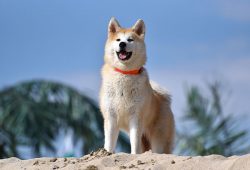The Akita (秋田犬 Akita-inu, Akita-ken) is a large breed of dog originating from the mountainous northern regions of Japan. There are two separate varieties of Akita: a Japanese strain, commonly called “Akita Ken” in Japan, “Akita Inu” (“inu” means “dog” in Japanese), or “Japanese Akita”; and an American strain, known as the “Akita” or “American Akita”. The Japanese strain called the Akita Inu comes in a narrow palette of colors, with all other colors considered atypical of the breed, while the American strain known simply as the Akita comes in all dog colors. The Akita has a short double-coat similar to that of many other northern spitz breeds such as the Siberian Husky, but long-coated dogs can be found in many litters due to a recessive gene.
The Akita is a powerful, independent and dominant breed, commonly aloof with strangers but affectionate with family members. As a breed, Akitas are generally hardy, but they have been known to suffer from various genetic conditions and be sensitive to certain drugs.
Appearance
As a spitz breed, the appearance of the Akita reflects cold weather adaptations essential to their original function. The Akita is a substantial breed for its height with heavy bones. Characteristic physical traits of the breed include a large, bear-like head with erect, triangular ears set at a slight angle following the arch of the neck. Additionally, the eyes of the Akita are small, dark, deeply set and triangular in shape. Akitas have thick double coats, and tight, well knuckled cat-like feet. Their tails are carried over the top of the back in a gentle or double curl down the loin.
Mature American type males measure typically 26–28 inches (66–71 cm) at the withers and weigh between 100–130 lb (45–59 kg). Mature females typically measure 24–26 inches (61–66 cm) and weigh between 70–100 lb (32–45 kg). The Japanese type, as stated in the breed standards, are a little smaller and lighter.
Breed standards state that all dog breed coat colors are allowable in the American Akita, including pinto, all types of brindle, solid white, black mask, white mask, self-colored mask, even differing colors of under coat and overlay (guard hairs). This includes the common Shiba Inu coloring pattern known as Urajiro. The Japanese Akitas, as per the breed standards, are restricted to red, fawn, sesame, brindle, pure white, all with “Urajiro” markings i.e., whitish coat on the sides of the muzzle, on the cheeks, on the underside of jaw, neck, chest, body and tail and on the inside of the legs.
Coat types
There are two coat types in the Akita, the standard coat length and the long coat. The long coat is considered a fault in the show ring, however. The long coat, also known as ‘Moku’ is the result of an autosomal recessive geneand may only occur phenotypically if both sire and dam are carriers. They have longer (about 3–4 inches in length) and softer coats and are known to have sweeter temperaments. It is believed that this gene comes from the now extinct Karafuto-Ken 樺太犬. Unlike their short coat cousins, the long coats are less highly prized and thus more affordable.
Grooming needs
American Akitas are a low maintenance dog breed. Grooming them should be an easy process. They are fairly heavy shedders and can go heavier than normal two to three times per year. Daily brushing could be a good way to reduce this problem. This breed needs to bathe every few months, although it can be more often, depending on the needs of each owner. Toenails should be trimmed every month, and their ears should be cleaned once a week. Another great way to reduce shedding is adding around 40 ml of olive oil and Omega3 for an adult Akita Inu each day, will help improving his overall coat condition and decrease its shedding.
On top of that, you should Add some vegetables and fruits to his diet.
Temperament
The Akita is generally seen as territorial about its property, and can be reserved with strangers. It is sometimes described as feline in its actions; it is not unusual for an Akita to clean its face after eating, to preen its kennel mate, and to be fastidious in the house. They are known to be intolerant of other dogs of the same sex, as stated in the AKC breed standard.
Since it is a large, powerful dog, the Akita is not considered a breed for a first time dog owner. The breed has been targeted by some countries’ breed-specific legislation as a dangerous dog. The Akita is a large, strong, independent and dominant dog. A dog with the correct Akita temperament should be accepting of non-threatening strangers, yet protective of their family when faced with a threatening situation. As a breed they should be good with children; it is said that the breed has an affinity for children. Not all Akitas will necessarily have the same temperament.
Akitas tend to take a socially dominant role with other dogs, and thus caution must be used in situations when Akitas are likely to be around other dogs, especially unfamiliar ones. In particular, Akitas tend to be less tolerant of dogs of the same sex. For this reason, Akitas, unless highly socialized, are not generally well-suited for off-leash dog parks. The Akita is said to be careful, courageous, fearless, and intelligent. Sometimes spontaneous, it needs a confident, consistent handler, without which the dog will be very wilful and may become very aggressive to other dogs and animals.
Akita (dog). (2017, June 29). In Wikipedia, The Free Encyclopedia. Retrieved from https://en.wikipedia.org/w/index.php?title=Akita_(dog)&oldid=788037207


